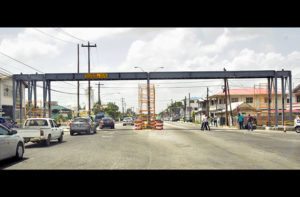By Jarryl Bryan
The rate at which new motor vehicles have been introduced locally has in fact exceeded the capacity of Guyana’s roads to accommodate them. This is according to a recent report from the Inter-American Development Bank (IDB), which threw a spotlight on this discrepancy.
According to the IDB’s “Reformulation of the road network, upgrade and expansion program” report, this situation is directly contributing to congestion and accidents.

“Georgetown faces limited road infrastructure combined with a rapidly growing fleet (of) 100,000 new registered vehicles over the last decade (which) contributes to congestion and accidents,” the report stated.
The report notes that limited infrastructure includes the average roadway’s two-lane configuration and pavement widths of 9-12m. The organisation said that 80 per cent of the pavements were in fair-to-poor condition.
“Traffic levels peak 1500 vehicles per hour on a road with capacity for 1,320 and no provision for non-motorized pedestrian (and) bicycle traffic,” the report also notes.
The Police Traffic Department had said it recorded a 26 per cent decline in fatal accidents for the period January 1, 2017 to May 15, 2017. Thirty-six fatal accidents and 40 deaths were then recorded, compared to 50 fatal accidents and 54 deaths over the same period last year.
There was also a 39 per cent decrease in overall accidents for the same period. Some 398 accidents have been recorded, as opposed to 651 accidents the previous year.
It is understood that private cars account for most of the vehicles involved in fatal accidents, standing at 12, while there were four pedal cycles, three minibuses, four motor lorries, four hire cars, one motor pickup and four motor cycles.
The GPF said speeding remains the major cause of accidents, accounting for 14 accidents in the first quarter of the year. Other causes were inattentiveness, driving under the influence of alcohol, failure to confirm to road traffic signs, and pedestrians crossing in the paths of approaching vehicle.
Guyana has, over the past week, witnessed a particularly gruesome accident that claimed the lives of five individuals. The mid-afternoon accident, which involved a car and a lorry, left dead Sabita Manglani, 42; Emmanuel Manglani, 18; Ethan Ramjit, 5; Reshma Seeram, and Dhanpaul Kishandayal, called Navin.
Reports are that Kishandayal was driving motor car PPP 3394 in an easterly direction on the Corentyne highway while the lorry was heading in the opposite direction when Kishandayal inadvertently drove into a pothole, lost control of the car, and slammed into the lorry.
The impact of the collision pushed half of the lorry off the road and sent the paddy-laden tray pitching into the back of a Honda wagon, removing its top half in the process.
Residents in the area of the accident said the parking of heavy-duty vehicles along the shoulders of the Corentyne Highway was of great concern, and they had always complained about this issue.
During the previous week, there was another accident in the same area, and that, residents said, was caused by the same hole. That accident left several persons hospitalised.
Regional Vice Chairman Dennis De Roop told Guyana Times International he had raised the issue with the Public Infrastructure Ministry on several occasions, but to no avail.
Under the previous Government, a road strategy plan was unveiled by the Guyana National Road Safety Council (GNRSC). It is believed that this strategy should be updated, however, and there had been talk that an updated document would be produced.
A National Road Safety Plan 2017-2019 was launched on May 03, 2017. The aim of the plan was to assist Guyana to meet the Decade of Action for Road Safety, 2011-2020 plan: to reach 50 per cent death reduction by 2020.
Infrastructure
Government has been taking steps to cater to pedestrians in its infrastructure planning. Though plans for a Diamond, East Bank Demerara (EBD) pedestrian overpass were scrapped, one is being built at Peter’s Hall. In addition, projects such as the Sheriff/Mandela extension are in the works.
The IDB is behind the “Road Network Upgrade and Expansion” programme, worth US$69.2million, having approved the operation following a request from the then PPP Administration. The objective of the Multiple Works (MW) Programme was to enhance urban and suburban mobility and safety by reducing vehicle operating costs, travel times and road fatalities.
The loan included civil works for primary roads, and safety components in the capital of Georgetown and surrounding regions. This included proposals to improve transport systems along Georgetown’s Sheriff Street-Mandela Avenue road, the sample project.



